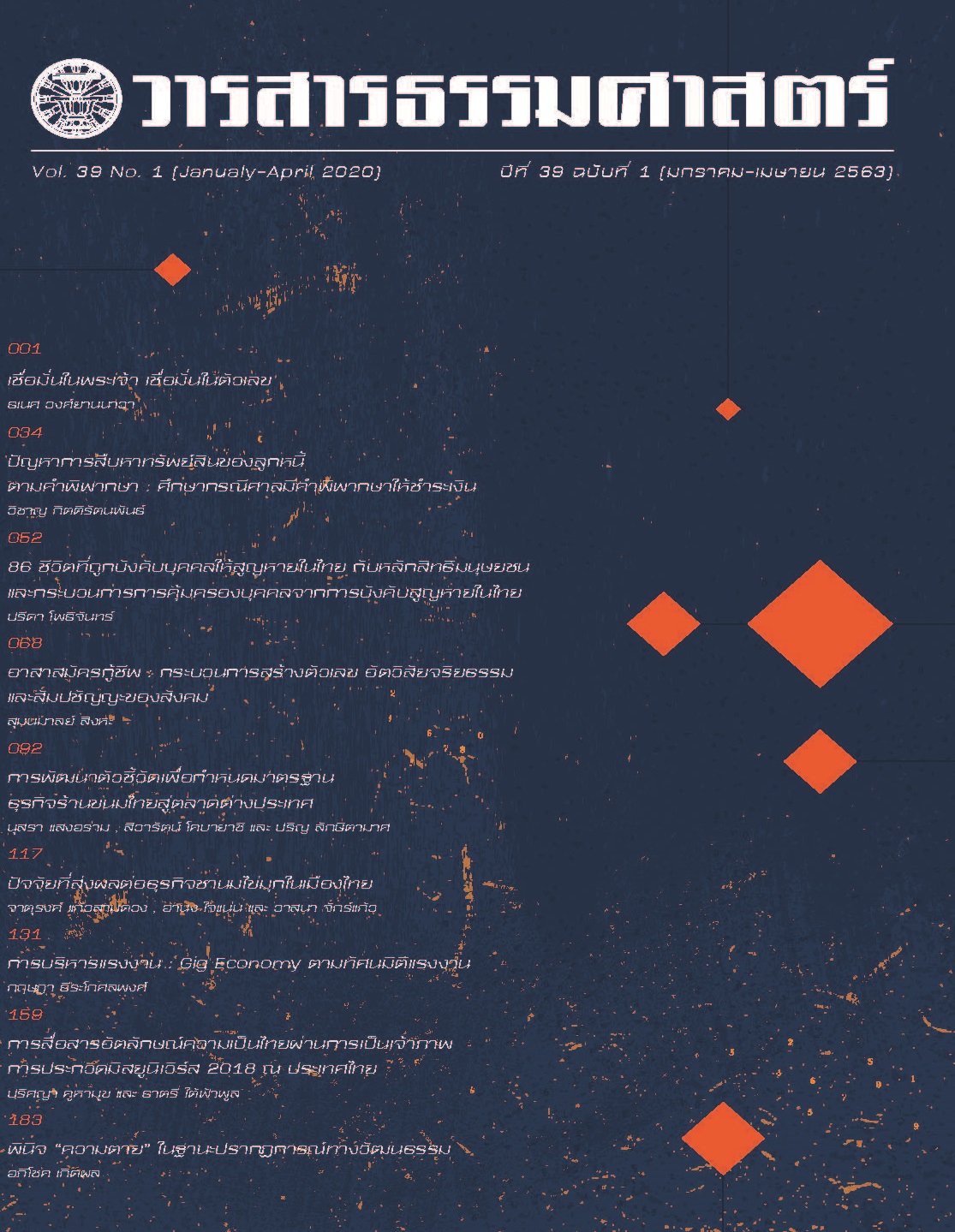Rescue Volunteers: Making Sense with Numbers: Ethico-Psychological Subjects and Social Sensorium
Main Article Content
Abstract
This article aims to understand the methodology of "statistical" representation of bureaucratic classifications which are constructed and negotiated, a reform and political boundaries of emergency service. This study draws on ethnographic method in Bangkok
suburb street where I conducted participatory observation with the rescue volunteers, emergency operational victims of road accidents, NGOs and bureaucrats. Findings show the knowledge of emergence epidemiology, whereby the evaluation of critical assistance relies on numbers and statistics, is totally compartmentalized, treated victims as a separated unit of information, apart from social interaction. The finding from face-to-face interview with 14 rescue volunteers reflect mix methodology between quantification operational authorities in terms of emergence epidemiology and emergency care experience of the volunteer communities, challenging the standard way “command and control” mode that cope with emergency and disaster management. The article concludes that rescue volunteers’ resistance reflects ordinary ethics and social sensorium in everyday life.
Article Details
References
กฤษณ์ธรรม กสิกรรังสรรค์. (2553). ปัญหาและอุปสรรคในการปฏิบัติหน้าที่ของรถพยาบาลกู้ชีพและ อาสาสมัครกู้ภัย: ข้อคิดเห็นจากมูลนิธิป่อเต็กตึ๊ง. สืบค้นเมื่อ 30 ตุลาคม 2562, จากhttp://breakingnews.nationchannel.com/read.php?lang=th&newsid=432733
จีรพล เหล็กเพชร, ประสิทธิ วุฒิสุทธิเมธาวี และ ประเสริฐ วศินานุกร. (2552). ระยะเวลาที่ผู้ป่วยสมองขาดเลือดใช้ในการเข้ามารับการรักษาที่ห้องฉุกเฉินของโรงพยาบาลสงขลานครินทร์สงขลา. นครินทร์เวชสาร, 27(3), 203-212.
ประชาธิป กะทา และ สิทธิโชค ชาวไร่เงิน .(2561). ระบาดวิทยาวัฒนธรรม. นนทบุรี: สำนักวิจัยสังคมและสุขภาพ.
สถาบันการแพทย์ฉุกเฉินแห่งชาติ. (2556). ช่องว่างการแพทย์ฉุกเฉินไทย: รายงานสถานการณ์ระบบบริการการแพทย์ฉุกเฉิน. สถาบันการแพทย์ฉุกเฉินแห่งชาติ.กรุงเทพมหานคร:เอ็น พี เพรส.
สถาบันการแพทย์ฉุกเฉินแห่งชาติ. (2556). แบบฟอร์มสมุดบันทึกผลการปฏิบัติงานพนักงานกู้ชีพสืบค้นเมื่อ กันยายน 2562, จาก http://www.rangsit.org/rescue_help/rescue_08.php
สถาบันการแพทย์ฉุกเฉินแห่งชาติ. (2557). สถิติการเข้ารับบริการระบบการแพทย์ฉุกเฉินของประเทศไทย. สถาบันการแพทย์ฉุกเฉินแห่งชาติ.กรุงเทพมหานคร: เอ็น พี เพรส.
สถาบันการแพทย์ฉุกเฉินแห่งชาติ. (2559). คู่มือ ระบบบัญชาการเหตุการณ์ทางด้านการแพทย์และสาธารณ สุขสำหรับการจัดการในภาวะสาธารณภัย/ภัยพิบัติ(Public Health Emergency Incident Command System: PHEICS) พ.ศ. 2559 . สืบค้นจาก https://www.niems.go.th/th/Upload/File/255906101538474568_d2Qw9e18HslgFn47.pdf
สพฉ. (2560). บันทึกเหตุการณ์การบริหารจัดการการแพทย์ฉุกเฉินในสถานการณ์ความไม่สงบ พ.ศ. 2553
อุบล ยี่เฮ็ง. (2553). การเผชิญภัยพิบัติถอดบทเรียน: กรณีความไม่สงบทางการเมืองในเขตกรุงเทพมหานคร (12 มีนาคม - 22 พฤษภาคม 2553). วารสารพยาบาลทหารบก,11(ฉบับพิเศษ). สืบค้นจาก https://tcithaijo.org/index.php/JRTAN/article/view/5595
ศ.นพ.อนันต์ตัณมุขยกุล. (2553). Man-made Disaster กับการแพทย์บทเรียนจากการขัดแย้งทางการเมือง เมษายน–พฤษภาคม 2553. วารสารอุบัติเหตุ, 29(2), 79-88. สืบค้นจากhttp://www.niems.go.th/th/Upload/File/20110601012336.pdf
Brown, H. (2010). “If we sympathetic with them, they’ll relax”: Fear/Respect and medical care in a Kenyan hospital . Medishe Anthropologie, 22(1), 125-142.
Chantharasorn, K. (1963). Itthiphon khong chao chin pon thalay lae botbat khong kon chinsamai-patchuban. [Influence of Oversea Chinese and The Role of contempoly Chinese]. Bangkok: Odean Store.
Douglas, D. (1969). Occupational and therapeutic contingencies of ambulance services in metropolitan areas. PhD dissertation thesis, University of California.
Gammon, G. (1995 ). Open forum: Fighting the superman syndrome. Emergency,27(2), 70.
Good, M.D., Good, B.J. & Grayman, J. (2015) . Humanitarianism and ‘mobile sovereignty’ in strong state settings: Reflections on medical humanitarian in Aceh, Indonesia. In Abramowitz, S. & Panter, B. C. (Eds.), Medical Humanitarianism: Ethnographies of Practice. University of Pennsylvania Press, Philadelphia, PA
Hewlett, S. A. & Luce, C. B. (2006). Extreme jobs: The dangerous allure of the 70 hour workweek. Harvard Business Review. 84(12), 49-59.
Howie-Willis, I. (1985). South Australians and St John Ambulance 1885 - 1985, Griffin Press,Adelaide, South Australia.
Latour, B. (1987) . Science in Action: How to Follow Scientists and Engineers Through Society. USA: Harvard University Press.
Livingston, J. (2012) . Improvising Medicine: An African Oncology Ward in an Emerging Cancer Epidemic. Duke university press.Durham & London
Lupton, D. (1999). Risk and sociocultural theory: new directions and perspectives. Routledge, London and New York.
Peterson, A. & Lupton, D. (1996). The new public health: Health and self in the age of risk. London: SAGE Publications.
Phaholyothin, N. (2017 ). Moving beyond charity to philanthropy? The case of charitable giving in Thailand. Austrian Journal of South-East Asian Studies, 10(2), 185-203.
Pol, A. (2002 ). The Body Multiple: Ontology in Medical Practice. Durham, Duke University Press.
Pols, J. (2006a). Washing the citizen: washing, cleanliness and citizenship in mental health Care. Culture, Medicine & Psychiatry, 30(1), 77-104.
Mol, A. (2008). The Logic of Care. Health and the Problem of Patient Choice, London: Routledge.
Sheehan, J (1995). Honorable mention: pictures of my past. Journal of Emergency Medical Services, 20(5), 85.
Thévenot, L. (2001). Pragmatic Regimes Governing the Engagement with the World. Schatzki, T. R., Knorr-Cetina, K. & Savigny, E. V. (Eds.) The Practice Turn in Contemporary Theory. Routledge. pp.56-73.
Valentine, D., Olson, V. A. & Battaglia, D. (2012). Extreme: Limits and Horizons in the Once and Future Cosmos. Anthropological Quarterly, 85(4), 1007-1026.

